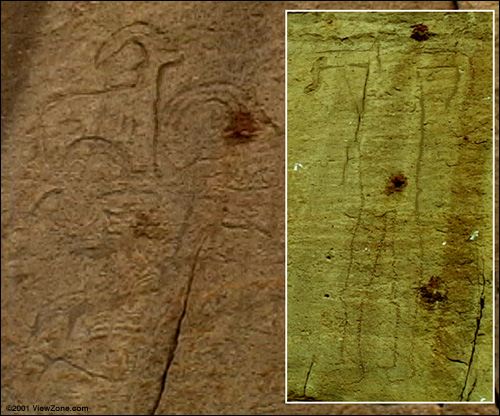 with ViewZone's Gary Vey
Ancient Artifacts: the first of many
On the way to the Rock Palace we stopped at a remote village. There was a rumor that some very old petroglyphs had been discovered by some children. Abdul skillfully drove the Land Cruiser over the rugged, rocky landscape until we approached the putt-putt-putt of a small diesel water pump. This sound meant civilization... albeit a small sheep farm. As soon as the Toyota's engine was switched off a crowd of children appeared as if from nowhere.
"Gholum! Gholum!" (Pen! Pen!)
I had heard this before from children that approached us in Sana'a. "Where did that phrase come from?" I inquired.
Ahmed explained, "Mostly from German and Italian tourists who give them pens. It's not so much they need pens but it is a way of asking for friendship..."
"La. Ana mafish gholum!" I didn't have any pens to share but Sky had some colored stickers that boys and girls stuck on their fingers. "Aywah."
Ahmed asked about the rock carvings and the children took us along a goat path to a steep rock ledge with a number of pecked shapes almost 20 feet above ground level.
The panel contained dozens of long and curved horns attached to quadrupeds. Each figure was about a foot wide and was formed by pecking the surface and carving the shape. Some archaeologists have called these shapes "goats" while others insist they are "ibex." Whatever they are, I have seen them all over the world in very old human habitation sites. They have been interpreted as hunting totems and metaphors for the human soul. They usually face right but this site has one or two facing to the left. There is also a life-size human torso, minus the head.
I looked for text or writing but there was none. Instead, a faint layers of much older carvings under the top layer revealed the same horned animals. Whatever these horned creatures represented to the ancients, they maintained the same image over many, many generations. Petroglyphs of this style have been dated to the Paleolithic age.
I photographed the entire wall in panels that can be pieced together later at very high resolution. "Surrah! Surrah!" (Take my picture!) The children were mesmerized by the digital camera.
This was just the first glimpse of many ancient petroglyphs we would see in Yemen -- including some important discoveries. Soon we would be leaving Sana'a for Marib and the legendary land of the Queen of Sheba. There was script at Marib considered to be some of the earliest forms of writing -- over 4000 years old.
|
Back to Yemen

